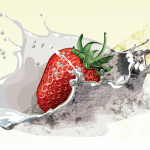 I’m a programmer.
I’m a programmer.
In my family, there is a very defined line between capabilities.
On one side of the line, you have the logic-oriented programmers, and on the other side of the line you have the artists.
And, as my Dad and fellow-programmer often says, “I don’t do graphics”.
You would have to hear the emphasis and take in his posture during such a statement to truly understand the humor behind it — but he’s not joking.
I, too, have difficulties on the graphical-front, but have found it necessary, from time to time, to dip my toes into the image-related kiddie pool.
My experience began with the Windows Paint program — back when the program was very pixelating — and hasn’t grown a lot since.
(And yes, that’s my brother that you can hear snickering in the background.)
Regardless, having gained some sense of the various types of graphical formats available, I’m tackling the subject today.
My goal is to highlight the differences between raster and vector images, as well as several of the most popular image file formats available.
Raster vs. Vector Graphics
Raster graphics are made up of colored dots, or pixels, arranged in a dot-matrix structure to form images.
They are not scalable (cannot be increased/decreased in size without losing resolution/quality).
Vector graphics are made up of instructions and formulas that detail the vector path and how to shape/fill/border it, etc.
They can be scaled (increased/decreased in size) without losing resolution, or quality.
Vector graphics are characterized by smooth, polished lines and shapes, while raster graphics are characterized by their natural, realistic qualities, especially in the form of photographs.
The most common vector graphic file format is probably the open standard SVG, standing for Scalable Vector Graphics.
Raster graphics include many of the most commonly-used file formats, such as .jpg, .gif and .png.
JPG/JPEG
JPG, or “jay-peg” is a popular image format for photographs and anything containing gradients and color variations, but is ultimately a lossy format that can deteriorate if it is re-sized, or saved/edited multiple times.
JPG does not support transparent images, but does support smaller file sizes than many other options.
PNG
PNG (short for Portable Network Graphics, and pronounced P.N.G.) is a loss-less image format that came onto the scene more recently than many of its alternatives, but gained support very quickly.
PNG supports transparent images but results in larger file sizes than JPG.
GIF
GIF (short for Graphics Interchange Format, and pronounced like “gift” without the “t”) is a loss-less image format that can be compressed into much smaller file sizes than JPG.
GIF supports transparent images and also animations, resulting in the common term “animated GIF”.
Other Types
The types of graphical formats mentioned above are universal, meaning that they can be read/opened/edited by the majority — if not all — image-capable programs.
There are many other types of graphical formats, most of which are unique to specific image-editing software that has to be installed for the file to even be viewed.
I will only list a few of the most common types of non-universal graphical file extensions here:
AI
BAT
BMP
CDR
EPS
EXIF
ICO
IMG
ODG
PDF
PPM/PGM/PBM/PNM
PSD
PSP
SVG
SWF
TIFF
WebP
XCF
Summary
I’m still making a valiant effort to edit my own graphics these days. If you wonder why, you should read about my sister’s photographer, and how he went on strike. (Hint: Her photographer is my go-to graphics guy. He’s also the brother you can still hear snickering in the background.)
I’m also making an effort to move away from bitmap. Despite the fact that Paint and KolourPaint have served me well for years, I have started exploring my other options.
And by options I mean Gimp. I refer to it in the plural, because it’s open source, and versions are available for Windows, Linux and OS X. So many options!
